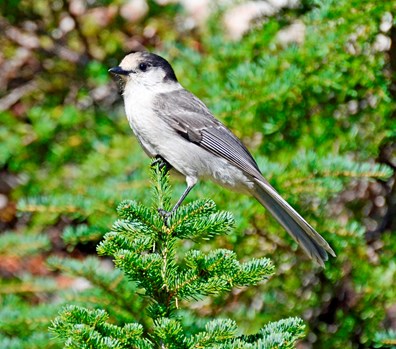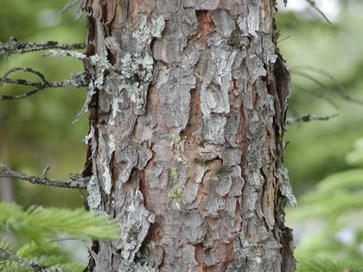Climate Change and Birds’ Resources
Thursday, February 1, 2018Canada Jay
Canada Jays, also known as Whiskey Jacks or Gray Jays, are robust birds abundant in the boreal forest and mountain ecosystems in Canada. Being very friendly and readily eating out of your hand, their curious and bold nature makes these charismatic birds loved by many. They are year-round residents, spending their summer and fall systematically stashing food caches into the bark and branches of spruce trees in order to survive the long cold winters. As early as February these hardy birds will start to nest and they are often able to raise their young with a surprising 80% success rate. Being a bird species found in every province and territory in Canada, the Canada Jay was nominated Canada’s National Bird by Canadian Geographic in November 2016.
What’s the problem?
Scientists in Algonquin Provincial Park have been researching Canada Jay populations for generations. Since the 1970s, they noticed that Canada Jay populations were declining. Each year one to two previously occupied territories were abandoned along their southern range and nests were found with abandoned eggs or dead young in them. After much research the scientists were able to determine that climate change is having a direct impact on our Canada Jays.
With climate change, the overall global temperature is continuing to rise, which is having a negative impact on Canada Jay populations. Canada Jays have enlarged saliva glands which they use to wrap insects and other food into small balls to store. By storing their food caches in spruce trees, Canada Jays have been taking advantage of the spruce tree’s resin, which has natural anti-microbial properties. These properties help to keep their food preserved and fresh for extended periods of time. This is especially important as Canada Jays often start storing food caches months before the winter freeze sets in.

With climate change, we are now seeing warmer and longer fall seasons occurring and the spruce trees just don’t have the preservative power to keep that food fresh for that long of a time. The Canada Jays’ food caches are spoiling before they can freeze. Consequently there is less food for them to eat over the winter and often by the time the chicks are about to hatch, the Canada Jays’ food resources are nearly depleted. They do not have enough food left to feed both adult and young so unfortunately, many of their young are now dying.
Over the long term this will cause not only their populations to decline, but also their range to shrink. For a bird that is so iconic to our Canadian boreal forest, it is hard to image that if this trend continues, one day they may no longer be around.
What can I do?
You can help the Canada Jay by reducing your impact on climate change. Climate Change is occurring because of the increased amounts of CO2/carbon emissions we are putting into the atmosphere. You can help reduce your carbon footprint by being more environmentally conscious. Reduce, reuse, recycle helps to reduce the amount of new products that need to be manufactured (and the emissions those factories produce). You can use or install solar power into your home, switch from incandescent to LED lights and turn off light switches when you leave rooms (this reduces the amount of coal and natural gas we need to burn for electricity). In winter, turn down your house thermostat at night to save money and fuel. If it’s a nice day outside, walk or bike to your destination instead of driving. These are all small, easy ways that we can each help to reduce the rate of climate change!

Photo Credit
C.J. Earle, 2003.07.14. The Gymnosperm Database. Retrieved from: http://www.conifers.org/pi/Picea_mariana.php Retrieved on Jan 26, 2018
Computing, technology, science, gadgets, future, mobiles, space, and machinery. Author admin - http://www.machinetics.com/led-vs-incandescent-semiconductors-kicking-edisonsbulb-curb/ Retrieved on Jan 26, 2018.
Grey Jay in Mount Rainier National Park, Washington State. By VJAnderson. 7 April 2019. https://commons.wikimedia.org/wiki/File:Gray_Jay_DSC6526.jpg
Grey Jay in Banff National Park, by Jakub Frys. 28 March 2019. https://commons.wikimedia.org/wiki/File:Grey_Jay_-_Banff.jpg
Additional Reading:
https://www.allaboutbirds.org/guide/Gray_Jay/id
https://www.canadiangeographic.ca/article/meet-our-national-bird-gray-jay
http://www.cbc.ca/natureofthings/episodes/what-trees-talk-about
http://www.cbc.ca/news/canada/nova-scotia/national-bird-grey-jay-canada-150-1.4187987
Blog Posts
- What is Climate Change
- Drought: What Can We Do?
- Migration and Climate Change; a Complicated Relationship (Part 1)
- Migration and Climate Change; a Complicated Relationship (Part 2)
- Climate Change and Birds’ Resources
- Ladder to Extinction
- Arctic Warming and Ecosystem Impacts
- Climate Change Connection to Mountain Pine Beetle
- Tackling Climate Change Denialism
- Impact of Climate Change on Bluebirds
- An Introduction to Climate Change
- Great Decline of Aerial Insectivores
- Role of Oceans in Fighting Climate Change
- Role Of Forests In Fighting Climate Change
- Impact of Climate Change on Shorebirds
- Impact of Hurricanes and Climate Change on Birds
- An Introduction to Climate Change.
- Impact of Forest Fires, and Climate Change on the Nature
- Impacts of Climate Change on Owls
- Impacts of Climate Change on Birds of Prey
- Whitebark Pine and Clark's Nutcracker
- COVID 19 & The Environment
- Impact of Global Warming on Bird Anatomy and Colour Polymorphism
- Climate Change & West Nile Virus
- All Posts

